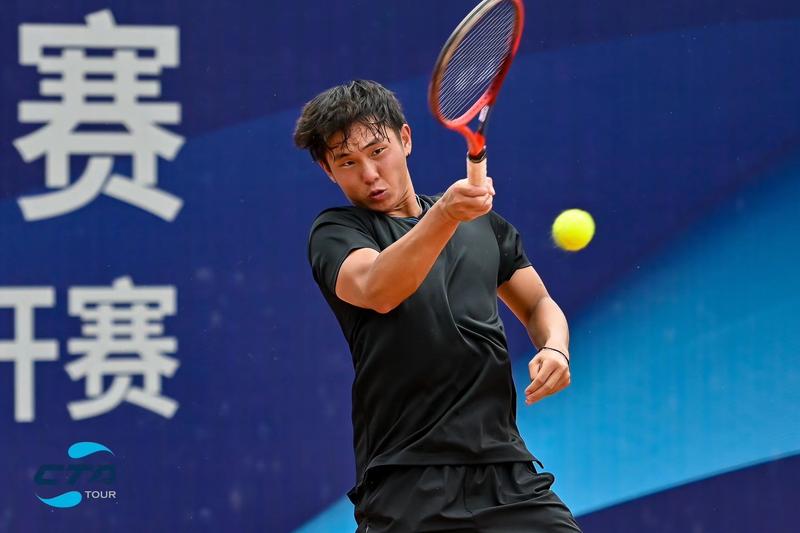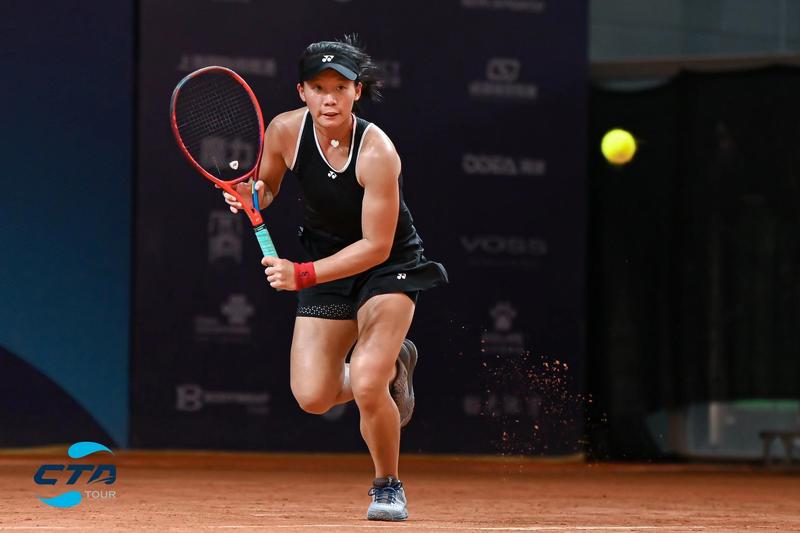 Mo Yecong in action during a title-winning campaign at last week’s opening leg of the 2022 CTA Tour in Changsha. The Chinese Tennis Association plans to build the domestic circuit into a ladder system that allows players to progress through the ranks before eventually joining international events. (PHOTO PROVIDED TO CHINA DAILY)
Mo Yecong in action during a title-winning campaign at last week’s opening leg of the 2022 CTA Tour in Changsha. The Chinese Tennis Association plans to build the domestic circuit into a ladder system that allows players to progress through the ranks before eventually joining international events. (PHOTO PROVIDED TO CHINA DAILY)
With a youth-focused domestic tour gaining momentum, the Chinese Tennis Association is stepping up its talent development efforts with a view to producing future Grand Slam success.
As the world's top professionals, including China's best, battle it out at Wimbledon, the country's young hopefuls have served notice of their intentions to join the major stage too, highlighted by some solid performances at last week's Changsha leg of the 2022 CTA Tour.
The eight-day tournament got the tour's third season off to a flying start on Sunday, raising the curtain on the seven-leg domestic circuit at a time when elite-level international events remain suspended in China due to the COVID-19 pandemic.
Showcasing aggressive yet consistent shotmaking during long rallies, top-seeded Mo Yecong outlasted schoolmate Wu Hao from Nanchang University, 6-3, 4-6, 10-5, in a seesaw final to claim the men's singles title. Earlier, teenager Li Zongyu beat Yang Ziyi in straight sets to win the women's trophy on the clay courts of Moon Island Tennis Center in Hunan's provincial capital.
Both obscure names in the tennis world at the moment, both Mo and Li have hailed the circuit as a critical steppingstone on their way to prominence on the professional stage.
It's quite important for a tennis player to play on a consistent basis, rather than just training without any competitions. The CTA Tour offers us much-needed competitive action, helping us stay in shape and maintain our form when we have no international events to play at home.
Mo Yecong, tennis player
"It's quite important for a tennis player to play on a consistent basis, rather than just training without any competitions," said Mo, a 21-year-old Hunan native.
"The CTA Tour offers us much-needed competitive action, helping us stay in shape and maintain our form when we have no international events to play at home," said Mo, who will travel to Europe later this month to resume playing on the International Tennis Federation's entry-level pro tour.
Li echoed those sentiments, adding that the experience of challenging the country's best pros on the CTA Tour has motivated her to work harder and dream bigger.
"It was quite a valuable learning experience to play her," Li said of her quarterfinal loss to China's former world No 12 Wang Qiang at the CTA Tour's Rizhao leg in 2020.
"I really appreciate the opportunities that the CTA Tour presents. It allows us to play against adult players of a higher level, so we can test ourselves and prepare for entering a higher level of adult events," said Li, who will also head to Spain to prepare for ITF tournaments.
READ MORE: 3 losses with Zhang's singles journey snapped at Wimbledon
Launched by the CTA in 2020 during the peak of the pandemic, the tour consists of four tiers of events-up from 200 to 1,000 categories-and opens to both amateurs and professionals as young as 14.
Funded by the governing body and local sponsors, the tour offers a prize pool of 800,000 yuan (about $119,000) at each of the top-tier 1,000 tournaments, bigger than most of the purses offered at ATP Challenger events, or the equivalents on the WTA's 125 series.
 Li Zongyu in action during a title-winning campaign at last week’s opening leg of the 2022 CTA Tour in Changsha. The Chinese Tennis Association plans to build the domestic circuit into a ladder system that allows players to progress through the ranks before eventually joining international events. (PHOTO PROVIDED TO CHINA DAILY)
Li Zongyu in action during a title-winning campaign at last week’s opening leg of the 2022 CTA Tour in Changsha. The Chinese Tennis Association plans to build the domestic circuit into a ladder system that allows players to progress through the ranks before eventually joining international events. (PHOTO PROVIDED TO CHINA DAILY)
With all the country's top aces resuming international action on pro circuits this year, the CTA plans to build the home tour into a ladder system for lower-ranked pros and even amateurs to first progress in the domestic ranks before eventually moving up to entry-level international events.
"We launched the tour initially hoping to offer warm-ups for the top players to keep in shape during the pandemic-enforced shutdown of international events," said Huang Wei, a vice-president of the CTA.
"Yet, it has flourished into an accessible and open platform today for all the up-and-coming young players to gain experience and hone their skills on a more regular basis."
Without a touring circuit at home before 2020, young players in China, who are not yet qualified enough to play on the ATP, WTA and ITF pro tours, lacked quality competitions to enter.
As the only two national-level fixtures, the year-ending domestic championships and the quadrennial National Games tournament used to only allow players developed in and registered with State-owned provincial sports teams to play, excluding plenty of family-supported young talents or players cultivated at commercial tennis academies out of the official domestic ranks.
The inclusive format of the CTA Tour, which opens qualifying draws to all interested players at each leg, is building a unique talent pipeline that links the national program to the grassroots game.
"It made it possible for every young player-no matter where he or she started-to stand out from the field, to be seen and tested, and eventually promoted to the national program," said Huang.
"It helps expand our talent search and stimulate greater enthusiasm at the grassroots level," he added.
ALSO READ: Everything clicking as Halep hits her stride
In an additional reform, the CTA will open a nationwide talent search next month at the Chinese Tennis Academy in Nanjing, where 20 juniors from the under-14 and-16 age groups will be drafted for a half-year overseas training program at renowned facilities in North America and Europe.
With places divided evenly between boys and girls, the program will take place annually over the next decade with 75 percent of the costs covered by the CTA and regional sports authorities. The youngsters' families will just have to cover the remainder of the travel and training fees, Huang explained.
"It will be a game changer for the future of tennis in China," said Huang. "Tennis is an expensive sport for the majority of ordinary Chinese families, but once we have the program in full swing, we will no longer set barriers for true talent to emerge and to receive proper training."


